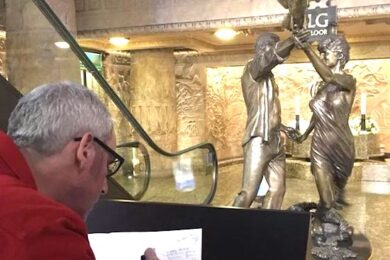The author pays homage at the Di & Dodi statue
Oh my god, it was beautiful. For a short period of time, the Princess Diana and Dodi Al Fayed statue (plus the bonus shrine) in Harrods was unquestionably London’s Greatest Tourist Attraction. It was free, but not enough people knew about it. Now it is gone and the public will never again gaze upon its pulsating, overpowering, discombobulating majesty. The Capital feels depleted as a result.
The Princess Diana and Dodi Al Fayed statue arrived fully formed in a flash of glory – that also somehow rode in on a cloud of rage – in September 2005. Fittingly, it was utterly unexpected, uncontrollable and unpredictable. This came eight years after the car crash in Paris that killed Diana and Dodi. Eight is not any sort of significant anniversary anywhere or for anything. That was the first and biggest clue that this was a piece of sculpture that was never going to play by the rules. Calendars are irrelevant in this instance. They cannot help you navigate the hows and whys.
The statue was there to right what Mohamed Al Fayed, father of Dodi and the owner of Harrods at the time, saw as a series of terrible and unconscionable wrongs. As a physical manifestation of grief and exasperation, it is as disquieting as it is powerful. We can only now talk of it in the past tense. Something so overpoweringly present should never dissolve into history.
Yet no one raged at its removal at the time. Many were glad to see the back of it. They were all, every one of them, wrong to do so. “Don’t it always seem to go,” sang someone many years ago about a taxi or something, “that you don’t know what you’ve got ‘til it’s gone?” Now it has gone, and that particular paradise was cruelly and crassly paved over, the time is finally right and proper to celebrate it in all its stupefying nobility.
The mise-en-scène of a masterpiece
The facts, as we know them, are as follows. The statue was designed by Bill Mitchell, a man who had been artistic design adviser to the Al Fayed family for over 40 years at the time. Mitchell had previously built a garret on the eighth floor of Harrods, he had masterminded its overpowering Egyptian Room and he later planned to put a zoo on the roof of the store.
Only he could be trusted with a job of this significance and importance. This was simultaneously to prove to be his Christ The Redeemer, his Aphrodite Of Knidos and his Lucille Ball. He was <a href="https://www.scotsman.com/news/al-fayeds-statue-of-liberty…



